Agency profitability playbook: Marketing agency operations, metrics, and profit margins
In partnership with Parakeeto 
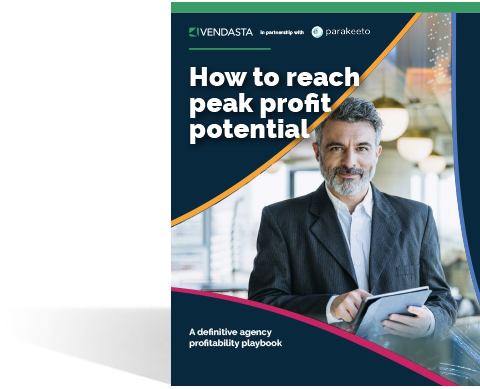
Keep reading to:
- Discover how to think more profitably as an agency owner
- Learn the key financial metrics you need to be watching and how to calculate them
- Master the art of project estimation and improve the accuracy of your client billing today
- Explore opportunities to fine-tune your systems and processes, taking control of profit margins
Executive summary
However, agencies struggling with profitability often have similar blockers, too. They lack a clear vision and strategy, which makes the path forward slow and convoluted. Their data and systems are messy and their agency operations are inefficient, making informed decision-making nearly impossible. Simply put, they are left guessing and stressing.
In fact, most agencies achieve less than 50 percent of their true profit potential.
So how can you grow your digital marketing agency profit margin, improve your agency operations, and ultimately scale and grow your agency?
Parakeeto Co-Founder and CEO Marcel Petitpas shares his insights on how agencies can zero in on what that winning profitability formula looks like for their businesses. Read on to:
- Discover how to think more profitably as an agency owner
- Learn the key financial marketing agency metrics you need to be watching and how to calculate them
- Master the art of project estimation and improve the accuracy of your client billing
- Explore opportunities to fine-tune your agency operations, systems, and processes, taking control of digital marketing agency profit margin
Use the insights shared in this playbook to help you make better, more informed decisions and unlock the gate to better agency operations that will enable you to grow your agency.
Expand your offering and
grow your revenue
Digital marketing agency profit margin 101
Failing to track the correct financial marketing agency metrics is one of the core reasons why agencies lose money. By not taking control of your data, you are led to make decisions that are ill-informed, steering you straight toward poor digital marketing agency profit margins and agency operations that aren’t humming along like they should.
In this section, Parakeeto Co-founder and CEO Marcel Petitpas shares his insights on how agencies should be thinking about profitability and their agency metrics.
How to Think More Profitably as an Agency
How do marketing agencies make money?
Let’s start with the basic formula for how marketing agencies make money with the goal of subsequently earning a profit. While we will go over these points in more detail later, here is a brief overview of the factors in the equation.
- Agency gross income (AGI). The revenue that agencies collect after subtracting all of the money that is simply passing through. For example, money spent on digital ads or payments going to external vendors is considered “pass-through.”
- Delivery costs. The cost of deploying time and resources to accomplish work for clients. If you subtract delivery costs from AGI, you are left with your agency’s “delivery margin.”
- Delivery margin. The amount of money left over after an agency has earned a dollar of revenue. The delivery margin can be the first indicator of how fundamentally profitable an agency’s service offering is.
- Overhead. All the fundamental costs of running a functioning business. Overhead costs may include office space, software, hardware, accounting for agencies, and more.
Did you know: According to Parakeeto CEO and Co-founder Marcel Petitpas, agencies struggling with low digital marketing agency profit margins tend to misdirect their focus on reducing overhead—even when overhead is already reasonable or lean. Instead, most agencies should focus their energy on their delivery margins to become more efficient at earning revenue and increasing profits.
A high-level understanding of the agency model for earning revenue expressed as an equation looks like this:

What does profit mean for marketing agencies?
Profit describes the financial benefit realized when revenue generated from a business activity exceeds the expenses, costs, and taxes involved in sustaining the activity in question, according to Investopedia.
Any profits earned funnel back to business owners, who choose to either pocket the cash or reinvest it back into the business. Profit is calculated as total revenue less total expenses.
But how can agencies ensure that they’re not only exceeding their profitability threshold but surpassing it with enough of a digital marketing agency profit margin to allow for sustainable growth?
Questions to ask before diving into marketing agency metrics
According to Petitpas, before you dive into agency metrics gleaned from using tools like agency time tracking software, agency CRM reporting, and project management software, there are some foundational questions you should be asking first.
To ensure you’re choosing the right path to become one of the most profitable businesses in the agency world, ask yourself:
- Who do we need to hire and when? Do they have the skills we need?
- What if we close this deal?
- What if we don’t close this deal?
- What if this deal starts two weeks later than planned?
- Are we making money on clients and projects, and if so, how much?
- Which clients or types of work are most and least profitable for us?
- Are we scoping projects properly?
- Did this take as much time as we thought it was going to when we sold it?
Sometimes, winning the work isn’t the hardest part of the job
To rise to the occasion and join the ranks of the most profitable businesses in the B2B space, your marketing agency not only has to become a master at winning new business but also realize it’s everything that happens after the sale that will determine whether or not a client is going to continue to contribute to your bottom line. This is critical to successful agency operations
There’s a lot of complexity involved in finding the answers to the questions agency owners have. You’re dealing with humans, you’re dealing with time, and it can feel like the business is happening to you instead of for you.
If you can get into a place where you can be looking ahead in your decision-making, it’s a game changer, according to Petitpas.
Digging into solving and answering the questions above will:
- Make the business more enjoyable to run
Help to set better expectations for clients
Ensure you’re not asking your teams to stay late to hit deliverables as often
Gain better visibility into the future profitability of the agency
Improve agency operations
Why marketing agencies should focus on their best-fit customer
Becoming laser-focused on the ideal clients that make the most sense for your business can help offer clarity in other areas of the work as well. Petitpas suggests this foundational work can help steer acquisition efforts and even inform your agency pricing model.
“When it comes to an agency pricing model, should you be lenient or should you be aggressive and stick to your guns at the risk of losing the client? There is math that you can look at to determine where on that spectrum you exist,” explains Petitpas.
Petitpas outlines two scenarios:
- Your agency is making one dollar an hour on a project. If utilization is low, it’s better to make one dollar an hour than to make nothing and let those hours go bad.
- If your agency is forecasting high utilization, or has several other opportunities in the pipeline, it may make more sense to stand your ground on pricing and keep the quality of your revenue high.
“What I see happening often is that owners are relying on their gut instead of what the agency metrics are telling them. They end up in a rut of systemic discounting when it’s not necessary. It ends up causing indigestion, which feels similar to starvation and has the same effect on the bottom line,” Petitpas says when discussing accounting for agencies.
Subscribe to our newsletter
Calculating the key marketing agency metrics for agency operations
1. Agency gross income (AGI)
Agency gross income is calculated differently than total agency revenue. According to Petitpas, you should strip out any income that could be considered “pass-through.” While pass-through income is revenue your agency is collecting from a client, the income is simply being passed on to a third party in the end. Examples of revenue that wouldn’t be included in AGI include:
- Digital ad spend
- Print budget
- White-label partners
- Contractors
Expert Tip: Exclude contractors from AGI if they are doing work that isn’t core to your business. However, if you’ve outsourced work to a contractor because you simply don’t have capacity and you are treating them as an extension of your internal team, you can bring them under your AGI umbrella and treat them as a delivery cost.
If you are looking for a number that represents AGI on your current profit and loss (P&L) statements, Petitpas says gross profit is likely a good place to start. However, speak to your accounting and bookkeeping council to understand the rules being used to determine what they are classifying as cost of goods sold (COGS).
2. Agency delivery margin
The next marketing agency metric you should be identifying is called delivery margin. This agency metric includes shared delivery costs, like subscriptions or tools, that are not necessarily needed for a single project but that a delivery team needs to carry out the work. Combining delivery costs with the delivery team salaries will get you to your delivery margin.
“When compared to your AGI, generally you’re aiming for a delivery margin of 50 percent or higher on the P&L at any given period of time,” Petitpas says.
The key here is to separate delivery salaries and software into their own account, as opposed to having all payroll and software for the business combined together. Doing so will make delivery margin much easier to calculate when looking at your financial statements.
3. Agency overhead
You will want to ensure you’re not spending more than 20 to 30 percent of your AGI on overhead costs like:
- Administration spending
- Sales and marketing spending
- Facility costs (rent, internet, phone, etc.)
Target a spend of 8–14 percent of your AGI on admin, 8–14 percent on sales and marketing, and 4–6 percent on facilities (assuming you have an office; fully remote teams may spend less than one percent on facilities). Those ratios are simply rules of thumb. As long as overhead (including founders’ salaries) land within 30 percent of AGI, spending is reasonably balanced.
Expert tip: Agencies should review the above agency metrics on a quarterly or even monthly basis, when they receive reports from an accountant or bookkeeper.
4. Average billable rate (ABR)
More easily accessible than delivery margin, ABR can give you a quick snapshot into the profitability of any given segment you want to examine on a weekly or even daily basis. Here is the formula to calculate ABR:
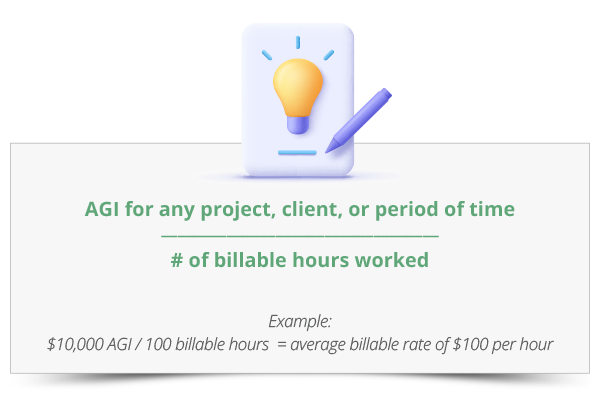
This allows for a much more detailed and timely analysis of trends and patterns in the business compared to relying on financial data and accounting reports.
5. Agency utilization
Looking at ARB alone will not provide a full picture of financial health and viability. Being extremely profitable on every project is great, but if the team’s capacity is not utilized to its full potential, your agency will still have low delivery margins.
Agency utilization is the measure of how much time is spent generating revenue for the agency (working on deliverables for clients), as opposed to time spent on other activities.
Here is the formula to calculate capacity utilization:
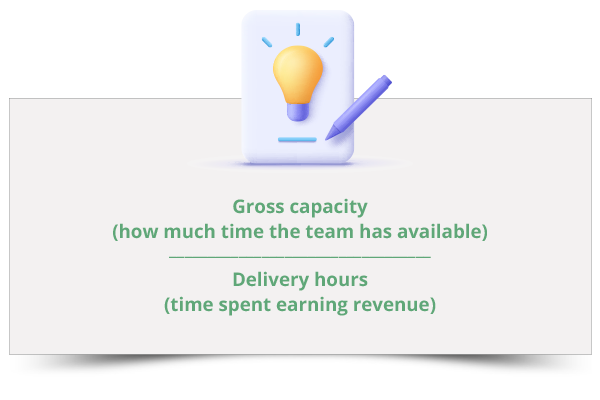
The main factor to demystifying agency utilization calculations is understanding capacity.
Here are a few important tips to keep in mind when you calculate capacity utilization.
- Capacity includes all working hours. For the average employee, this will look like 40 hours per week for 52 weeks per year, equalling 2,080 hours.
- Capacity includes all employees. If your agency wants insight into how team composition impacts utilization, even team members that do not complete billable work for clients must be included in the capacity utilization calculations.
- Capacity gets harder to measure with added variables. It is best to keep things simple, and for this reason Petitpas advises against deducting things like vacation time, sick days, and holidays from the capacity utilization calculations. “The substantial increase in cost and complexity doesn’t add much, if any, additional value or precision to this agency metric,” Petitpas says.
- Capacity must be consistently understood across the organization. Every agency must understand how capacity is measured to encourage healthy goal setting and avoid misunderstandings within the team.
Similarly, you must also get on the same page regarding what a delivery hour is. In short, a delivery hour is any time spent doing work for clients or moving a client deliverable forward. Simple as that.
Questions that DO NOT impact delivery hours:
- Did it change the price for the client?
- Was it on budget or not?
- Was it productive or not?
There is only one question that matters: Was this done for a client or client project? If yes, then it’s a delivery hour.
To calculate utilization rates, Petitpas suggests looking at the total amount of time a person has and compare that to the billable hours they logged.
Example:
John Smith has 2,080 hours available in a calendar year
John clocked 1,400 billable hours
John was 67 percent utilized during the timeframe
Utilization targets for the purely billable members of your agency’s team should sit around 75–95 percent in a normal week and be 10–20 percent lower on an annual basis to account for paid time off (PTO), holidays, etc. Targets for the entire team combined should hover around 60 percent for the year.
6. Scoping accuracy
“Agencies need a feedback loop to tell them when they were out in left field when they put a proposal together. Maybe it took twice as much time or maybe the development portion of a website build was way off. If so, then there’s no way for agencies to tighten that up and make it more accurate over time,” Petitpas says.
At the end of each project, measure how close you came to the assumptions you made at the beginning of the project. You should be aiming to consistently fall within 10 percent of the initial scope for fixed scope engagements.
Read more on scoping accuracy and project estimation in the next section of this guide.
Marketing agency metrics: Takeaways
Agencies should view delivery margin as the delta between delivery cost and AGI. Two of the ways to increase delivery margin are:
- To decrease delivery cost or find more inexpensive talent to work (much easier said than done)
- Increase the amount of AGI those people can earn with their available time (this is most often the lever agencies should be focusing on)
AGI is fundamentally a function of capacity x utilization x ABR.
Therefore, increasing utilization and ABR increases the AGI that the same group of people can earn in a given period of time. It also improves the delivery margin.
An example:
10,000 hours of capacity x 50 percent utilization x $100 ABR = $500,000 in AGI
10,000 hours of capacity x 60 percent utilization x 100 ABR = $600,000 in AGI
10,000 hours of capacity x 60 percent utilization x $125 ABR = $750,000 in AGI
If we assume the delivery cost of the 10,000 hours of capacity doesn’t change in all three of these scenarios, we are able to increase the AGI earned by that same amount of capacity by 50 percent just by making small improvements to capacity utilization and ABR.
That 50-percent increase is often the difference between being super profitable and losing money. ABR and capacity utilization are really simple and effective marketing agency metrics you can use to get frequent feedback to determine whether things are heading in the right direction.
By implementing the checks and balances above, you can reduce uncertainty and build a repeatable decision-making process in your agency operations based on data rather than assumptions. In turn, your agency can join some of the most profitable businesses on the data-driven decision path.
Accounting for agencies: How to excel at project estimation
You don’t want to dump 10 hours into a well-thought-out proposal only to have it be declined. But if you don’t spend enough time on the fine print, your project scope may get away from you.
In this section, we share the four steps that have helped dozens of agencies make data-driven decisions that only become stronger and more reliable with time.
The Agency Profitability Flywheel

- Defining estimation techniques and formats
- Installing quantitative feedback loops (time and cost tracking)
- Establishing reporting and feedback cadences
- Defining process optimization cadences
Steps one and two are focused on getting estimations out quickly, without compromising on accuracy.
Steps three and four focus on actionable feedback from the team, improving profitability, efficiency, and consistency, and making the work they do more predictable over time through better processes.
Step one: Defining your project estimation techniques and formats
First, your agency should standardize the estimation system in place. It’s a given that agencies work with different clients on a variety of diverse projects. Even so, there is still a way to create a template that can be used each time a project is estimated for a client.
Start by answering the following question:
What are the assumptions that, if proven inaccurate, could have the largest impact on our agency profits, project cost, and people? Would it force us to absorb costs or work a lot of overtime?
Usually, the answer will require two things:
- Identifying your scoping metrics
Expert tip: Ask yourself, “if the client needs more _____ , then effort will increase by ________.” For example, if the client needs two more web pages, it’s going to take six more hours of freelancer time. Then, add on your marketing agency profit margin.
2. Simplifying data structures and reducing complexity
Expert tip: Ask yourself, “What’s the sequence of questions I go through when a project goes wrong?” For example, do you focus on the phase or step in the process that went awry? Or are you more focused on people or departments?
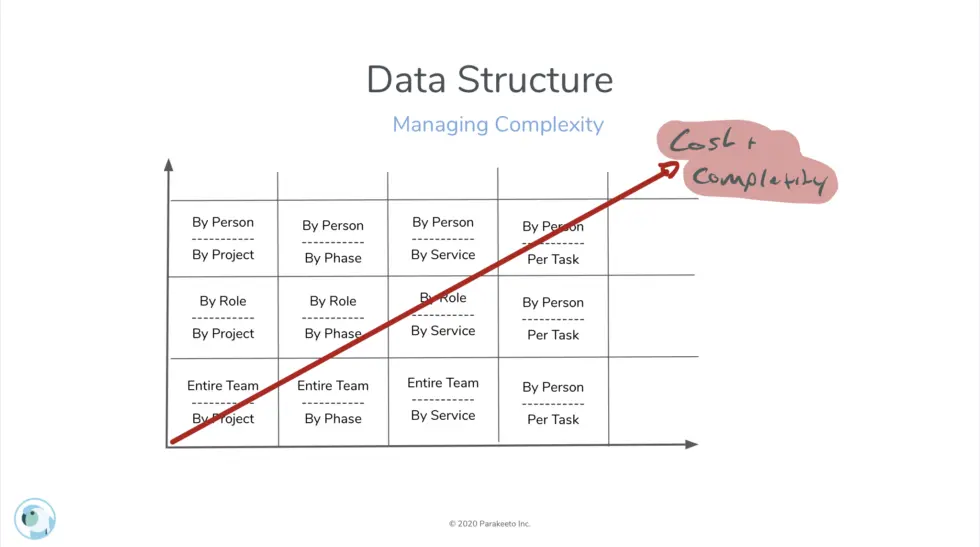
For example, if a client is looking for a website project, you might ask five standard questions during every discovery call to ensure you understand the scale.
A project cost estimate for agencies may then be structured using the following points:
- Client
- Project
- Phases (workshop, wireframing, copy, design, development)
- Roles (project manager, designer, writer, developer, strategist)
- Phases (workshop, wireframing, copy, design, development)
- Project
You should aim to create a similar structure for estimates to begin comparing points to one another over time.
It’s critically important to create horizontal consistency. Without this, it will be hard to compare past projects to one another and see patterns and trends in the data.
Step two: Agency time tracking and cost tracking
After you’ve defined and standardized a process, the next step is to install a feedback loop that places data points on the graph below, slowly building the relationship line to strengthen it with time.
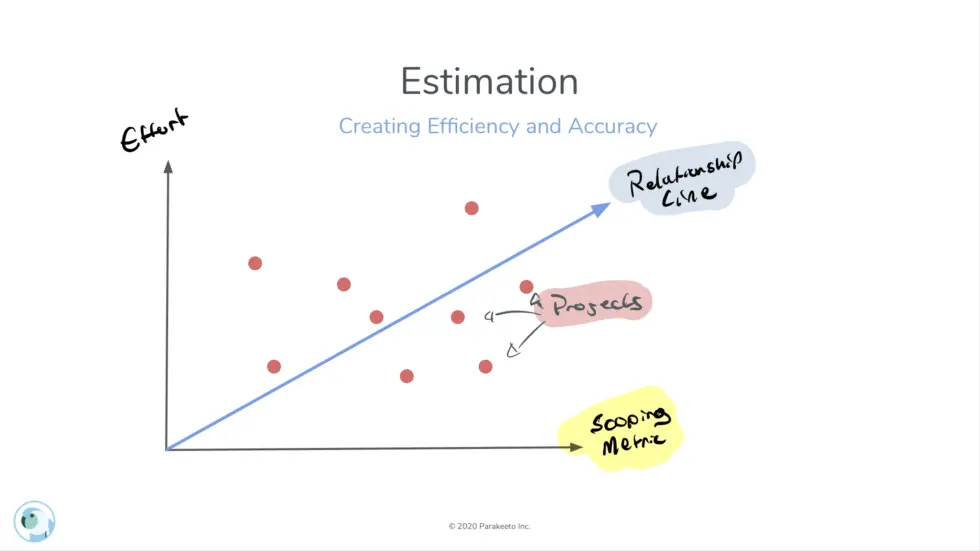
1. Clashing project management and operational structures
How is your agency time tracking set up, and is everyone on the same page? If not, it’s time to consider the various ways time can be tracked and to streamline.
-
- By function or role
When it comes to the ops team, project cost estimates for agencies are usually broken down by function or role.
Example: x hours of development, xx hours of design, xx hours of project management, etc.
-
- By task
The project management philosophy, on the other hand, is more aligned with tasks.
Example: X hours on the content outline, XX hours on the wireframes, XX hours on Q/A, etc.
-
- According to your agency time-tracking tool
The problem is exacerbated by the fact that most agencies use time-tracking tools, which structure projects in their own specific way.
-
- Internal labeling conventions
Additionally, inconsistent naming or labeling can skew data. Consider your agency is working on the design element of a project, yet naming it differently each time (“web design,” “designer,” and “graphic designer”).
When the same role or task is called different things, you will not have consistent data across different projects to compare, analyze, and make decisions. It will also add unecessary friction to reporting as a painful data cleanup process will be required for effective agency operations.
2. Lacking proper tooling for agency time tracking, project management, and cost tracking
Once you’ve decided on a consistent structure for your data with horizontally aligned naming conventions, you know exactly what you need from your project management tool to begin implementing.
But not each tool will be a “fit” for every agency.
Research is key. According to Petitpas, his clients have found the right fit with project management tools such as:
- ClickUp
- Monday.com
- Asana
- Teamwork
Next is an agency time-tracking tool. It doesn’t need to be an all-in-one tool (for time tracking and project management). From Petitpas’s experience, all-in-one tools can be extremely mediocre and end up leaving out useful or key features that you’d get from a single, specialized tool.
If you are going to use agency time tracking that is integrated with a project management tool, make sure you can use tags, custom fields, or naming conventions to map every time entry back to the same format you’re using on your estimates.
Without this, your agency time-tracking data will be essentially worthless when it comes to driving future project cost estimates for your agency. This is because it will not easily provide feedback on how you performed relative to estimates without a lot of data cleaning.
However, even with the right tooling in place, there’s another issue to acknowledge: The team might hate time tracking. It’s important to acknowledge this potential blocker, while also being transparent about how important agency time tracking is.
Here are a few tips for teams dragging their feet.
Bake it into the culture
Getting a team on board with your agency’s time tracking is more than just a 30-minute meeting going through how to do it. The agency culture must promote the importance of time tracking as a critical component in measuring performance and profitability. This is achieved by actually engaging the team in the application of that data to improve their quality of life.
Give transparency to get transparency
Your team must also understand how important it is to be truthful and transparent about their time spent, not because you don’t trust them, but because of how it impacts decision making and agency operations. Involving them in the meetings and discussions where time is used to quantify what happened on projects is probably the easiest way to achieve this.
Do not use agency time tracking to discipline or police
Don’t use it to measure productivity. Only ever use it to facilitate discussions about how and why things didn’t go the way you assumed they would when it was scoped and to find opportunities to make agency operations more efficient. Trying to discipline employees for going over budget or not being given enough work to do is a very fast way to destroy timesheet compliance and create a culture of lying on timesheets to appease sentiment.
Step three: Data-driven conversations with the team
After steps one and two, you’re in a position to finally tackle data and how to use it in a project cost estimation system.
First, meet with the team to uncover the context behind projects that go much better or worse than expected.
The best way to do this is through project performance meetings or project retrospectives. The difference between the two is that retros are at the end of projects, whereas performance meetings are on a fixed cadence (e.g., weekly or monthly).
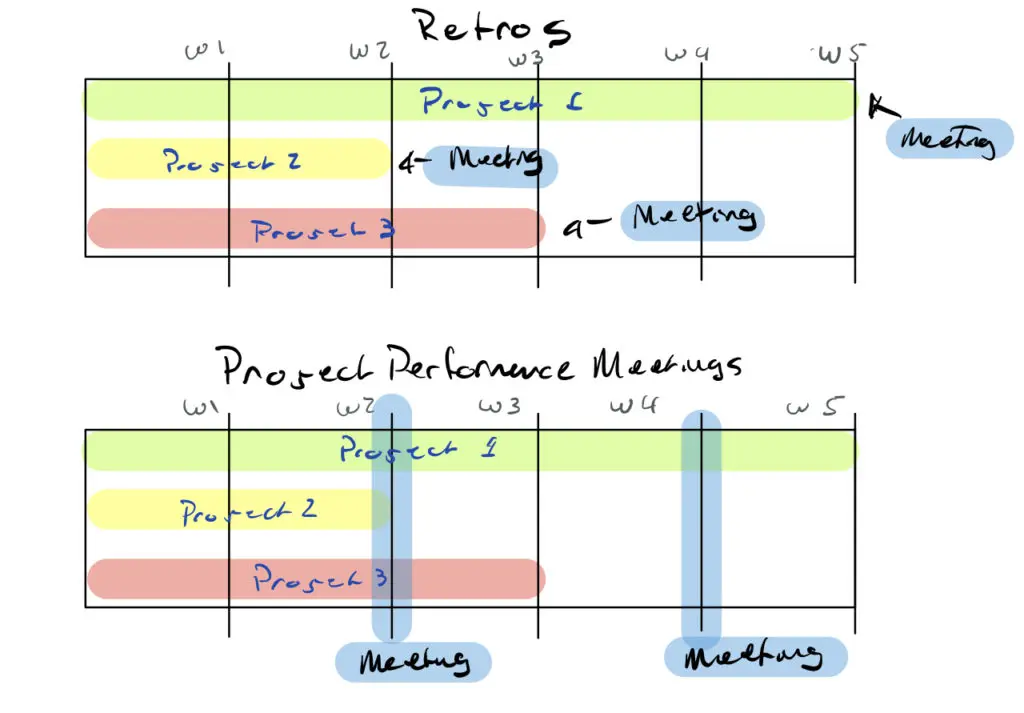
- Compare project cost estimates for your agency vs. actuals for all projects
- Discuss where things are and are not going to plan and why
- Draw out ideas from the team about opportunities for improving a process or scoping
- Translate decisions into action items and engage the team in implementing them
Here are three expert tips to make these meetings successful (and not dreaded by the team), especially when broaching the topic of what is not going to plan:
1) Focus on the process, not the people
Rarely will you see a person fail miserably with a well-thought-out process as their foundation. So, instead of approaching a project that went over budget like this:
“Tim, you spent twice as much time on project management during this project as was budgeted, why is that?”
Say this:
“It looks like our estimate on project management was off by about half. Any ideas on what may have caused that gap?”
2) Drive the meeting, but don’t steal the spotlight
It’s important to take a bit of a backseat in this conversation, and just chime in when the team gets stuck. After all, you likely weren’t in the trenches to see exactly how it was playing out. Or, even if you were, it’s important that your team feels ownership over these projects and the ideas that are surfaced on how to improve the process.
It will greatly increase the likelihood of a successful process iteration down the road as the team will have come up with and created the process on their own.
3) Make it a priority, not an optional add on
It’s important that you also show the team how integral their feedback is to process improvement and efficient agency operations. That means sticking to your promise and implementing these meetings as part of the project rather than as an optional call.
Block out time for the team to implement the learnings that come out of these meetings.
Step four: Process improvement cycles
Process improvements will lead to more consistent time investments for work, which become easier to predict the more you do it.

Delivery processes
First, define the framework used to make iterations on agency processes. Petitpas’s team likes to create a backlog of improvements that can be made (usually these action items come out of retro and performance meetings) and then tackle them in sprints. In doing so, processes improve, but that doesn’t mean the team stops adding to the backlog. The backlog is a never-ending cycle of improvement.
Expert tip: Petitpas uses the I.C.E. score to prioritize the backlog. “It helps us decide what can wait and combines it with what has the greatest impact relative to the effort involved in implementing it,” he says.

Project cost estimation techniques for agencies
It is then important to regularly revisit your project cost estimation techniques. You’re going to want to take the data gained from previous projects (including cost and time tracking) and map it against your agency metrics for scoping.
You can build a full library of projects and group or tag them by size, scope, and service. Ideally, the relationship line will become stronger and stronger, making project cost estimations for your agency more reliable as time goes on.
The end result should be the ability to take the previously discussed scoping questions and plug them into a model that uses data to help you predict the time it will take to complete.
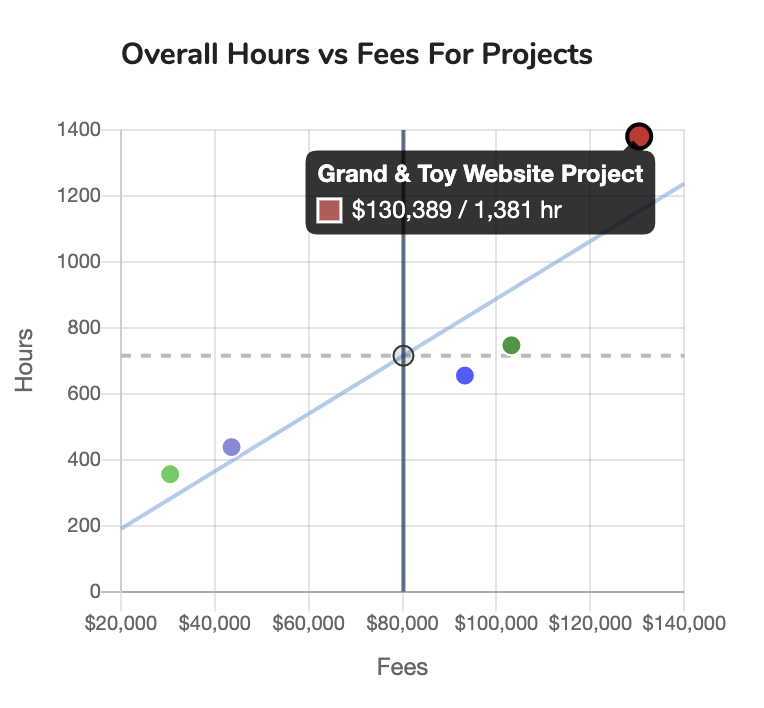
The client needs a website with 30 pages, a custom ecommerce widget, and an email marketing integration. The client has an approximately $50,000 budget.
Based on that information, you think they’re about a 5/10 on the website complexity scale (from the most to the least complex you’ve worked on).
Based on past projects, your agency should be estimating around:
- 32 project management hours
- 65 design hours
- 60 development hours
- 18 quality assurance hours
All that’s left to do is apply that last 10 percent of judgment and start modeling different agency pricing model scenarios to make sure your digital marketing profit margins are in the right place.
Project profitability targets
The last question you should spend a moment answering is: how profitable should a project be?
There will be nuance here, but assuming your agency is in a position to have the client walk away without capacity utilization rates plummeting, you should be aiming for 10–20 percent higher than your delivery margin target on the profit and loss statement. Usually that means aiming for 60–70 percent delivery margin or higher.
What does this mean?
In short, the delivery cost required to complete the project will be 30–40 percent of the agency gross income (AGI) you’ll bring in from the project.
Here’s how to calculate your delivery margin:
Delivery Margin = (AGI – Delivery Costs) / Delivery Costs
Read more about the details of calculating cost-per-hour and calculating profit margins.
Agency delivery margin calculation example:
Total project fees: $15,000
Pass-through expenses: $5,000
AGI: $10,000
Cost: 100 hours x average cost of $25/hr = $2500
Delivery Margin = ($10,000 – $2,500) / $10,000 or 75 percent
Expert tip: If you know your average cost per hour, you can quickly get a read on your delivery margin by calculating your ABR and plugging that into a delivery margin calculation.
Long-term gain
A good system for project cost estimation can make or break your agency. It keeps your team happy, your clients satisfied, and your agency profitable. It is an essential ingredient to quickly and easily predict project profitability and plan accordingly.
Investments in project cost estimation and clean data are the foundation of an agency’s operations systems. Investing a few moments in applying more structure to your estimation and agency pricing model process today can deliver value for many years to come.
Download this free framework including the flywheel in Parakeeto’s Agency Profit Toolkit.
Scale your agency with time and cost tracking
Agency profitability coach Marcel Petitpas is familiar with the story of how a solution can turn into yet another problem.
Petitpas asks, if you don’t have clarity on what the tools are supposed to give you in terms of data, then are you in a good position to be evaluating whether a tool is right for your agency?
The answer is no.
Petitpas shares exactly how to do the work that’s needed to determine what data you’re trying to get out of a tool. This will enable you to effectively evaluate your current tooling and determine whether you need different tools to track reporting and measurement (and ultimately improve profitability and grow your agency).
The keys to growing your agency? Scoping accuracy and agency time tracking.
Many digital marketing agencies like yours struggle with having a clear vision on how to measure performance. They also face messy data and systems, which only compound the issue. Fortunately, you can begin properly setting up your systems and tools in order to eliminate these challenges.
How savvy agencies set themselves up to scale
Setting up the right strategy to investigate a profitability problem
Your accountant rushes into your office, frazzled, and exclaims, “We have a profitability problem!”
What do you do?
How do you go about investigating that? It can be nearly impossible to determine why you’re struggling to make a profit on projects if you don’t have agency time tracking and cost tracking structure alignment.
If your time-tracking tasks aren’t aligned with how your agency’s project cost estimates are set up, your team will likely be making guesses about scope. It will come as no surprise that you have a profitability problem if those estimates are off.
When you have perfect alignment between how your estimates are created and how your time-tracking tool is set up to track data, it’s a different story. It’ll be a lot easier to not only create more accurate project cost estimates for your agency but to investigate profitability problems that may arise.
Designing the right system to align estimates and agency time tracking
To wrap your head around how your scoping and time-tracking system should be structured, use Parakeeto’s Incident Investigator™ exercise. When thinking about this exercise, consider a scenario where you have a project that went totally off the rails. Consider which questions you’d want to ask to determine what went wrong and why your profitability was so bad.

Parakeeto’s Time Tracking Mapper™ may help. Use the exercise below to think about whether the line items on your project cost estimates map to your time-tracking tool. Which time-tracking objects match to these estimate metrics in your agency?
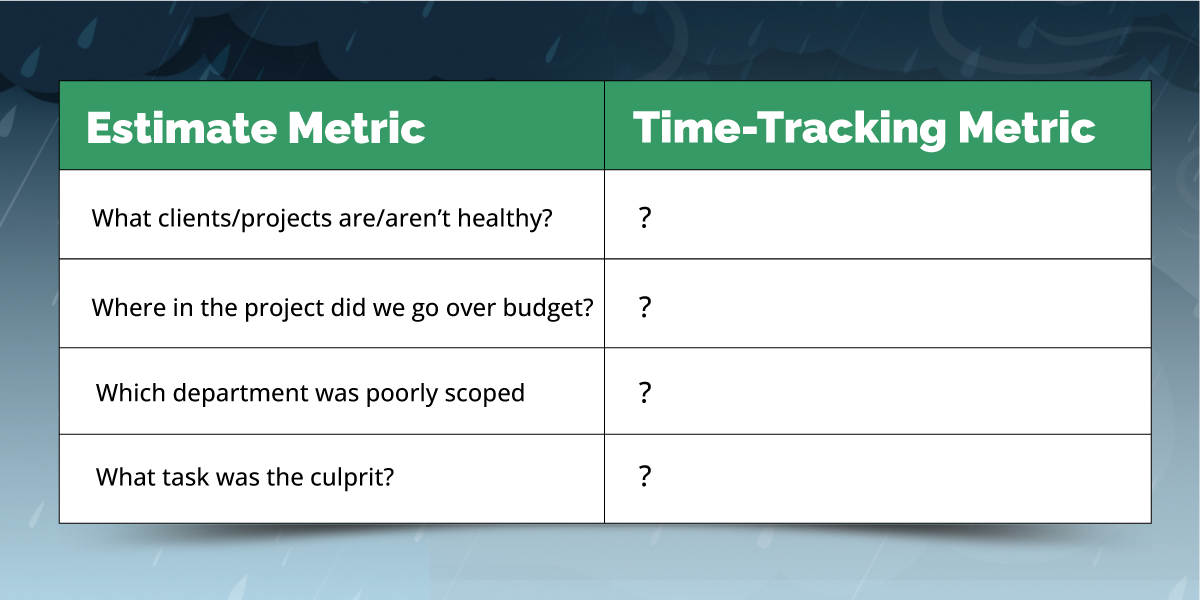
Managing complexity in data
There’s one important note to consider when setting up your time-tracking tool: beware to manage complexity.
There’s this idea that precision equals accuracy. If you can be more precise and detailed, if you can know exactly how much time was spent on a subtask within a task within a deliverable within a milestone within a phase within a project, then that more precise data will let you be more accurate.
Right?
Wrong.
In fact, the opposite is true. It gets infinitely more expensive to get your team to track time at that level. What’s more, compliance in time tracking will go down with each layer of complexity you add to time tracking. You’ll then face more inconsistent data and have more buckets of data to contend with.
Often, agencies over-index on precision where they reach a point of diminished returns. This is where being 5 percent more precise adds 0 percent additional accuracy to the high-level insight you’re trying to get. The more you try to increase the level of precision, the higher the cost and complexity. This is poor agency operations.
“When you go in and determine how you should use your agency time-tracking tool, and which pieces of information you need on every time entry so you can match it back to the estimate, start with the simplest viable solution,” Petitpas says.
Start simple:
Track by:
- Client
- Project (Use type tags for common projects (e.g., Website Builds))
- Role (Use a few major buckets (e.g., Project Management, Content, Design, Development))
You don’t want 500 unique tasks estimated for a project that you somehow then have to align to in your time-tracking or project-management tool. You want to put all those tasks in bigger buckets, like Design and Development, so you can map them back to a data scheme. As Petitpas explains, “You need some mechanism to group discrete tasks back to broader buckets to build data models around them.”
Don’t break it down any further than the agency time tracking example above. That’s the key to getting started: Keep it simple to start and get your team on board. Then you might realize that you don’t need any additional data or you might see where you need to drill deeper.
Ultimately, less complexity is better to start, so you can get compliance up before you go deeper. Petitpas explains, “If you can just have a conversation with the team to determine where you went over budget, that’s a much easier way to get insight than tracking extra layers of data that can’t provide the why.”
Using reference-class forecasting to accurately measure projects
To set up this new system, you must clearly define each part of the structure: clients, projects, and roles/tasks. You also need to ensure this structure is used consistently across projects and that your time-tracking or project-management tool can measure these data points.
If this is done consistently over time, and if you have this structure really well-defined, you can then improve your agency’s project cost estimates with reference-class forecasting.
Reference-class forecasting is based on a set of historical data, and the key is to understand the reference classes, such as how much design time is required on website projects.
With very little data, such as 5, 6, or 7 projects under your belt using your new structure, you can have a really reliable data line that can improve estimation efficiency and accuracy. You’ll be able to clearly see how much time was required for projects vs the budget in the past. This can eliminate bottoms-up guesswork, and it offers a faster and more accurate way to measure projects that require almost no context or expertise.
Closing the gaps and increasing agency profitability
The data can never tell us why the data is, it can only tell us what it is. This can leave gaps that need to be filled.
However, once you have the right strategy, structure, and data, you can start to fill in the gaps on detail by using reporting, feedback, and process optimization.
At the end of the project (or monthly for recurring projects), run a report to determine the estimate vs the actual and ask:
- What happened?
- Why did it happen?
- What can we learn?
This can close the gap.
Remember: A conversation with the team is a far richer way to get context. Sometimes it’s best to rely less on precise data and more on conversations with your team to determine how to improve the efficiency of your business.
With this information, you can then conduct process improvements to continue to increase profitability on projects and scale your agency.
Turn agency profitability into a process
If you can dive into the actions, inefficiencies, and outcomes that influence the profitability of your agency you can adjust your strategy, processes, and mindset to scale. You can improve your agency operations to enable you to ultimately scale your agency.
Vendasta works with agencies to accelerate their growth and create a repeatable motion, turning agency operations success into a process. Through our cloud Marketplace you can expand your offering, enjoy wholesale pricing and choose your own marketing agency profit margins to develop new, profitable revenue streams.
Find out more about working with Vendasta to access the tools you need to streamline your sales process, improve your agency operations, and scale your agency to reach peak profitability.
Agency profitability management w/ Marcel Petitpas
How to make your agency more profitable, with Marcel Petitpas
How to optimize your agency for profitability – Marcel Petitpas From Parakeeto
How to think more profitably as an agency | Marcel Petitpas [Podcast]
How to identify the right pricing strategy for your agency, with Marcel Petitpas [Podcast]
How savvy agencies set themselves up to scale
Want a profitable agency? Understand these dynamics [Podcast]
Frequently asked questions


What is a utilization rate?
Agency utilization is the measure of how much time is spent generating revenue for the agency (working on deliverables for clients), as opposed to time spent on other activities.
How to calculate billing rate?
AGI for any project, client, or period of time divided by the number of billable hours worked gives you the billing rate. The average billable rate (ABR) can give you a quick snapshot into the profitability of any given segment you want to examine on a weekly or even daily basis.








